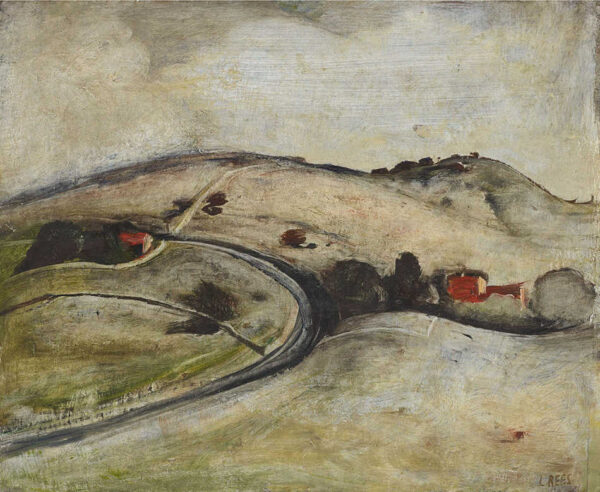Rhythm

If you walk through any Australian pastoral grassland, taking a route that allows your journey to effortlessly follow the shape of the land, you may also be walking along an ancient path used by other people; an artefact of sorts, of the travels and rhythmical movements of earlier lives.
The artefact may be invisible; still there, however, buried in the ground below your feet as you walk along a ridge or through a gap between two hills or beside the remnant shoreline of an old sea. The ancient path still exists, as traces that may only be detectable as a subtle shift in the colour or compaction of the earth, or as charcoal left from a hundred hearths dotting places along the way — or it could be wholly visible, as a present day road that traces the old journeys.
In 1947 the Art Gallery of New South Wales purchased a small painting by Australian artist Lloyd Rees. Painted in Gerringong on the states south coast The Road to Berry has captured a ‘rhythmical movement’ (Rees’s words) in the scene — the curves of the roads and fencelines, the folds of the hills, the placement of houses as two patches of vermilion in an otherwise sombre grassland — an atmospheric landscape, sensory in its effect on people, that appears to have touched many, including myself.
***
Australia, 1940s. A man sits under a tree in Gerringong, southern New South Wales. He looks at a road winding through some grass covered hills; and, allowing that artists are free to invent whatever they ‘see’: he sees clouds (probably), houses (probably), scatterings of trees (most likely). The small canvas board in front of him is still blank but the landscape is loaded.
We can’t know what he is thinking, or if what he is thinking has anything to do with the rhythmical movement he applies to the canvas that he later says, ‘just happened’. We can know however, with only a little magical thinking that the rhythm and movement is already there — under the hills, running through the grassy slopes, inside the houses, floating through the woven air of the sky — ancient pathways, changing seasons, old climate patterns, species evolving and becoming extinct, billions of births and deaths, houses, ruins, shifting shorelines, moving fencelines. The unwritten history of the landscape’s rhythmical movement is inseparable from the moment’s fleeting view.
Something of the landscape got into a person sitting under a tree in Gerringong. We can often sense this, without needing to understand why — that when we enter a landscape the landscape enters us.
*
Lloyd Rees quote from the Art Gallery of New South Wales web archive:
The Road to Berry is a tiny picture I remember painting from under a copse of trees … and I just remember a small canvas and a sort of rhythmical movement that just happened; I was always amazed at the attraction it had … I was never able to repeat that little picture, and that’s a good thing.
artgallery.nsw.gov.au/collection/works/7940
